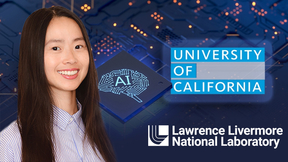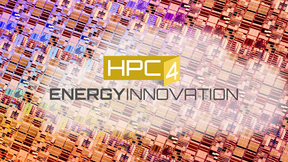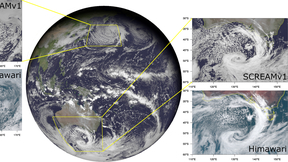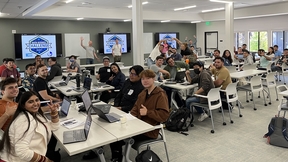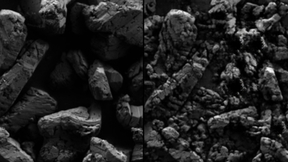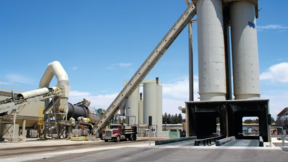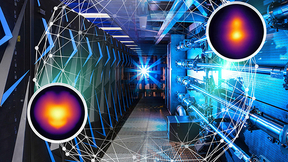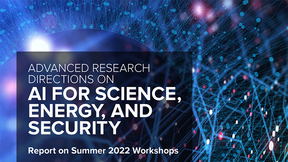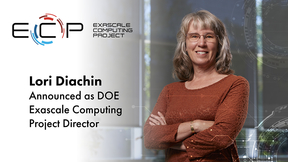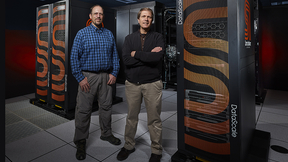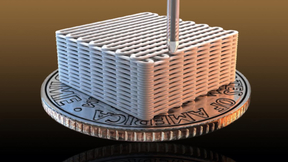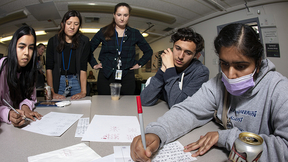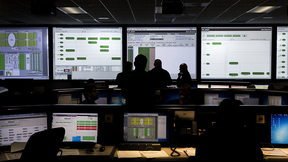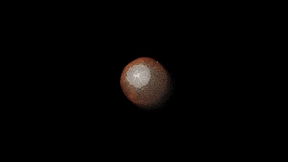Back
Computing
LLNL’s Data Science Summer Institute hosts student interns from Japan
Lawrence Livermore National Laboratory’s Data Science Summer Institute (DSSI) hosted summer student interns from Japan on-site for the first time, where the students worked with Lab mentors on real-world projects in artificial intelligence (AI)-assisted bio-surveillance and automated 3D printing. From June to September, the three students — Raiki Yoshimura, Shinnosuke…
LLNL, University of California partner for AI-driven additive manufacturing research
Lawrence Livermore National Laboratory (LLNL) today announced that Grace Gu, a faculty member in mechanical engineering at the University of California (UC), Berkeley, has been selected as the inaugural recipient of the LLNL Early Career UC Faculty Initiative. The initiative is a joint endeavor between LLNL’s Strategic Deterrence Principal Directorate and UC national…
HPC4EI workshop to highlight opportunities for supercomputing to shape manufacturing’s future
The High Performance Computing for Energy Innovation program will be hosting a special in-person workshop to discuss further deployment of high performance computing (HPC) to advance manufacturing on Oct. 18-19 at Lawrence Livermore National Laboratory’s (LLNL) University of California Livermore Collaboration Center (UCLCC) The workshop will explore future developments in…
Lab scientists and engineers garner three awards for top inventions in R&D 100 competition
Lawrence Livermore National Laboratory (LLNL) scientists and engineers have netted three awards among the top 100 inventions worldwide. The trade journal R&D World Magazine recently announced the winners of the awards, often called the “Oscars of innovation,” recognizing new commercial products, technologies and materials that are available for sale or license for…
LLNL scientists among finalists for new Gordon Bell climate modeling award
A team from Lawrence Livermore National Laboratory (LLNL) and seven other Department of Energy (DOE) national laboratories is a finalist for the new Association for Computing Machinery (ACM) Gordon Bell Prize for Climate Modeling for running an unprecedented high-resolution global atmosphere model on the world’s first exascale supercomputer. The Gordon Bell submission, led…
LLNL team reaches milestone in power grid optimization on world’s first exascale supercomputer
Ensuring the nation’s electrical power grid can function with limited disruptions in the event of a natural disaster, catastrophic weather or a manmade attack is a key national security challenge. Compounding the challenge of grid management is the increasing amount of renewable energy sources such as solar and wind that are continually added to the grid, and the fact that…
UC Merced & UC Riverside tackle Data Science Challenge on machine learning-assisted heart modeling
For the first time, students from the University of California (UC) Merced and UC Riverside joined forces for the two-week Data Science Challenge (DSC) at Lawrence Livermore National Laboratory, tackling a real-world problem in machine learning (ML)-assisted heart modeling. Held in the Livermore Valley Open Campus’s newly remodeled University of California Livermore…
Explainable artificial intelligence can enhance scientific workflows
Machine learning techniques are increasingly being used in the sciences, as they can streamline work and improve efficiency. But these techniques are sometimes met with hesitation: When users don’t understand what’s going on behind the curtains, they may lack trust in the machine learning models. As these tools become more widespread, a team of researchers in Lawrence…
DOE announces additional funding for HPC4Energy Innovation projects
The Department of Energy (DOE) today announced $3.9 million for 13 public-private partnerships that will apply high performance computing (HPC) to manufacturing processes and advanced materials, including a Lawrence Livermore National Laboratory (LLNL) collaboration to decarbonize asphalt production. The awards, representing DOE’s fall 2022 round of funding for the High…
High-performance computing, AI and cognitive simulation helped LLNL conquer fusion ignition
Part 10 a series of articles describing the elements of Lawrence Livermore National Laboratory’s fusion breakthrough. For hundreds of Lawrence Livermore National Laboratory (LLNL) scientists on the design, experimental, and modeling and simulation teams behind inertial confinement fusion (ICF) experiments at the National Ignition Facility (NIF), the results of the now…
Visionary report unveils ambitious roadmap to harness the power of AI in scientific discovery
Innovations in artificial intelligence (AI) are rapidly shaping our world, from virtual assistants and chatbots to self-driving cars and automated manufacturing. Seizing on the potential of AI to transform science, the nation’s leading experts in science and technology have released a blueprint for the United States to accelerate progress by expanding its capabilities in…
LLNL’s Diachin takes helm of DOE’s Exascale Computing Project
Lawrence Livermore National Laboratory’s Lori Diachin will take over as director of the Department of Energy’s Exascale Computing Project on June 1, guiding the successful, multi-institutional high-performance computing effort through its final stages. Diachin, who is currently the principal deputy associate director for LLNL’s Computing Directorate, has served as ECP’s…
LLNL and SambaNova Systems announce additional AI hardware to support Lab’s cognitive simulation efforts
Lawrence Livermore National Laboratory (LLNL) and SambaNova Systems have announced the addition of SambaNova’s spatial data flow accelerator into LLNL’s Livermore Computing Center, part of an effort to upgrade the Lab’s cognitive simulation (CogSim) program. LLNL will integrate the new hardware to further investigate CogSim approaches combining artificial intelligence (AI)…
Energy Inks wins regional FLC award
A Lawrence Livermore National Laboratory (LLNL)-developed technology known as Energy Inks has won a best in region award for the Far West region from the Federal Laboratory Consortium for Technology Transfer (FLC). This is the technology’s second award in the past nine months, as it received an R&D 100 award last September as one of the top 100 industrial inventions in…
Girls Who Code ‘Altamont Connection’ brings students from Livermore and Tracy to the Lab
High school students from Livermore and Tracy visited Lawrence Livermore National Laboratory (LLNL) on May 5 for a first-of-its kind event bringing the two cities’ Girls Who Code (GWC) programs and others together on-site for group activities and tours under a new “Altamont Connection” moniker. The event, which included tours of the National Ignition Facility, Discovery…
Computing codes, simulations helped make ignition possible
Part 6 in a series of articles describing the elements of Lawrence Livermore National Laboratory's fusion breakthrough. For Lawrence Livermore National Laboratory (LLNL) physicist George Zimmerman, and for the hundreds of physicists, computer scientists and code developers who have worked on fusion for decades, computer simulations have been inexorably tied to the quest…
Computational Engineering is key to ignition success
In a room illuminated by blinking lights and glowing monitors, more than 2,000 synchronized computers are triggered to run 5 million lines of code. The intricate code language is responsible for aligning and firing 192 laser beams — and carrying some 800 channels of target diagnostic data — efficiently and reliably several times a day. This isn’t a scene from a science…
First-ever hybrid Women in Data Science Livermore event celebrates achievements, supports women in the field
Celebrating International Women’s Day on March 8, Lawrence Livermore National Laboratory (LLNL) women data scientists, Lab employees and other attendees interested in the field gathered at the Livermore Valley Open Campus for the annual Livermore Women in Data Science (WiDS) regional event held in conjunction with the global WiDS conference. Attendees met online and in…
High-fidelity simulation offers insight into 2013 Chelyabinsk meteor
On the morning of Feb. 15, 2013, a small asteroid exploded over Chelyabinsk, Russia, sending a loud shockwave and sonic boom across the region, damaging buildings and leaving around 1,200 people injured. The resulting meteor, with a diameter of approximate 20 meters (roughly the size of a six-story building), was one of the largest to be detected breaking up in the Earth’s…
HPCwire names LLNL’s Terri Quinn among 2023 'People to Watch'
The publication HPCwire today announced Lawrence Livermore National Laboratory’s Deputy Associate Director for High Performance Computing (HPC) Terri Quinn has been named among its “People to Watch” for 2023. Celebrating its 21st year, the annual HPCwire program recognizes HPC professionals who play leading roles in driving innovation within their chosen fields and make…



